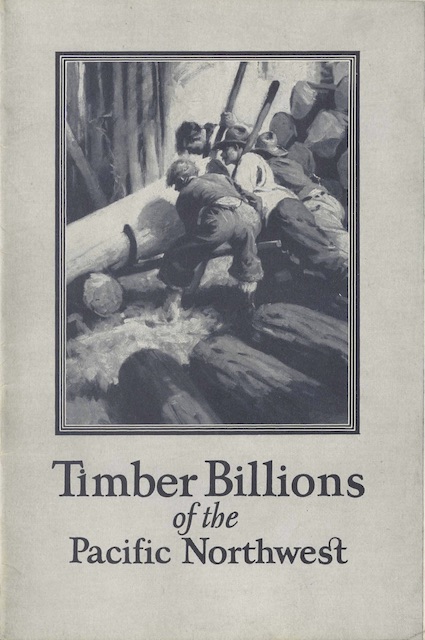This is one of a series of booklets promoting the Pacific Northwest published by the Burlington along with its parents, GN and NP. We’ve previously seen one on world trade and one on minerals — but in the Northwest, timber was and is far more important than minerals.

Click image to download a 8.9-MB PDF of this 36-page booklet.
The phrase “timber billions” probably refers to billions of board feet (a board foot is one foot by one foot by one inch), not billions of dollars. The booklet estimates that the Northwest had a little over a trillion board feet of standing timber in 1925, most of it Douglas-fir in western Oregon and western Washington. While still standing, however, this timber was worth under a tenth of a penny a board foot in 1925, which means the total was worth something less than a billion dollars. After being cut down and transported to markets, of course, it was worth a lot more, but in those days most of the timber was pretty remote so the costs of getting it were high, which is why the Northwest had half the standing timber but produced less than a third of the nation’s wood supply.
Still, the booklet accurately predicted that the nation would eventually come to rely on Northwest timber much more. Within 50 years of when this was published, Oregon was the nation’s leading timber producer, followed closely by Washington.
The booklet estimated that Oregon was home to 480 billion board feet of wood, nearly half of all of that found in the Northwest. After 80 years of cutting, the Forest Service’s most recent inventory estimates Oregon has 475 billion board feet of softwood timber and another 16 billion of hardwoods. This is partly because the 1920 inventories were underestimated, but it is also a testament to the rapidity with which Oregon timber grows back after cutting.
One thing the booklet failed to predict was the increased efficiency applied to wood product production. “The tendency of requirements for timber to increase instead of diminish is world-wide,” it says. In fact, despite tremendous population growth, we cut about the same amount timber today than we did in 1925: roughly 40 billion board feet per year. This is because we use it a lot more efficiently: much less is used as firewood or discarded as waste.
In any case, the railroads published this booklet to promote Northwest timber, but it doesn’t specifically encourage people to move to or invest in the Northwest. Instead, it vaguely invites people to “get away from your business for two or three or four weeks and go out and see this new empire of industry in the Pacific Northwest. Make it a vacation with a double value—rest and a first-hand knowledge of a country that will be the center of an extraordinary industrial development during the years just ahead.” Of course, when they do, it encourages them to take Burlington, Great Northern, and Northern Pacific lines.
